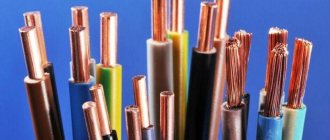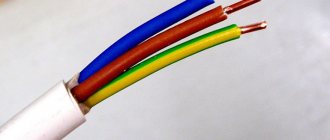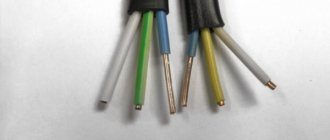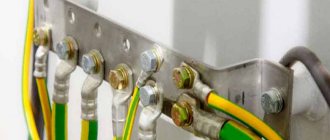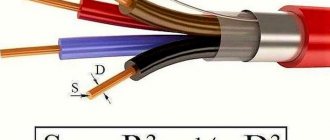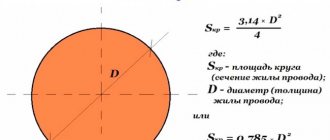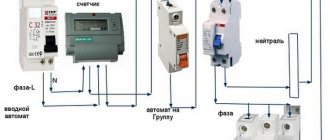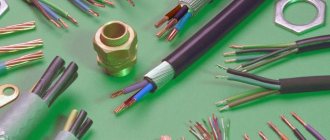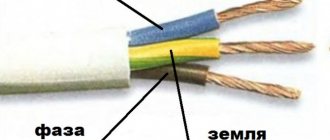Calculation of wire cross-section
Strictly speaking, the concept of “thickness” for a wire is used colloquially, and the more scientific terms are diameter and cross-sectional area. In practice, the thickness of the wire is always characterized by its cross-sectional area.
In practice, calculating the wire cross-section is very simple. Knowing the diameter (for example, by measuring it with a caliper), you can easily calculate the cross-sectional area using the formula
S = π (D/2)2 , where
- S – wire cross-sectional area, mm2
- π – 3,14
- D – diameter of the conductor of the wire, mm. It can be measured, for example, with a caliper.
The formula for the cross-sectional area of a wire can be written in a more convenient form: S = 0.8 D² .
Amendment. Frankly, 0.8 is a rounded factor. A more accurate formula: π (1/2)2 = π / 4 = 0.785. Thanks to attentive readers
Let's consider only copper wire , since it is used in 90% of electrical wiring and electrical installations. The advantages of copper wires over aluminum wires are ease of installation, durability, and reduced thickness (at the same current).
But with an increase in diameter (sectional area), the high price of copper wire eats up all its advantages, so aluminum is mainly used where the current exceeds 50 Amperes. In this case, a cable with an aluminum core of 10 mm2 or thicker is used.
The cross-sectional area of the wires is measured in square millimeters. The most common cross-sectional areas in practice (in household electrics): 0.75 (prohibited in fixed wiring), 1.5, 2.5, 4 mm2
There is another unit for measuring the cross-sectional area (thickness) of a wire, used mainly in the USA - the AWG system . On Samelektrika there is a table of wire cross-sections according to the AWG system and conversion from AWG to mm2.
Regarding the selection of wires, I usually use catalogs from online stores, here is an example of copper. They have the largest selection I've ever seen. It’s also good that everything is described in detail - composition, applications, etc.
I also recommend reading my article about choosing a wire cross-section for direct current; there are a lot of theoretical calculations and discussions about voltage drop, wire resistance for different cross-sections, and which cross-section to choose is optimal for different permissible voltage drops.
And another article - Voltage drop on long three-phase cable lines. a real example of an object is given, formulas and recommendations are given on how to reduce losses. Wire losses are directly proportional to current and length. And inversely proportional to resistance.
When choosing the cross-sectional area of the wires, you should be guided by three basic principles.
- The cross-sectional area of the wire (in other words, its thickness) must be sufficient for the passage of electric current through it. Sufficient - this means that when the maximum possible current in this case passes, the heating of the wire will be acceptable (as a rule, no more than 60 0C)
- The cross-section of the wire must be sufficient so that the voltage drop across it does not exceed the permissible value. This is especially true for long cable lines (tens and hundreds of meters) and high currents.
- The thickness of the wire and its protective insulation must ensure its mechanical strength, and therefore reliability.
For example, to power a chandelier in the living room, light bulbs with a total power consumption of 100 W (current slightly more than 0.5 A) are used. It seems that wires with a cross-sectional area of 0.5 mm2 are quite enough? But what electrician in his right mind would install such a wire in a ceiling slab? In this case, 1.5 mm2 is usually used.
In fact, the choice of wire thickness depends on one parameter - the maximum operating temperature.
If this temperature is exceeded, the wire and the insulation on it will begin to melt and collapse. In other words, the maximum operating current for a wire with a certain cross-section is limited only by its maximum operating temperature. And the time that the wire can work in such conditions. Below is a well-known table of wire cross-sections for selecting the cross-sectional area of copper wires depending on the current. The initial data is the cross-sectional area of the conductor.
What load can aluminum wires with a cross section of 1, 1/5, 2, 2/5 square withstand, what can be connected?
Table of load capacity of electrical wiring made of aluminum wire
Wire diameter, mm 1.6 1.8 2.0 2.3 2.5 2.7 3.2 3.6 4.5 5.6 6.2
Wire cross-section, mm 2.0 2.5 3.0 4.0 5.0 6.0 8.0 10.0 16.0 25.0 30.0
Maximum current under continuous load, A 14 16 18 21 24 26 31 38 55 65 75
Maximum load power, watt (VA) 3000 3500 4000 4600 5300 5700 6800 8400 12000 14000 16000
Table of power and current consumption by household electrical appliances at a supply voltage of 220 V
Household electrical appliance Power consumption depending on the model of the electrical appliance, kW (BA) Current consumption, A Note
Incandescent light bulb 0.06 – 0.25 0.3 – 1.2 Current value constant
Electric kettle 1.0 – 2.0 5 – 9 Continuous operation time up to 5 minutes
Electric stove 1.0 – 6.0 5 – 60 With a power of more than 2 kW, separate wiring is required
Microwave oven 1.5 – 2.2 7 – 10 During operation, the maximum current is consumed intermittently
Electric meat grinder 1.5 – 2.2 7 – 10 During operation, depending on the load, the current consumption changes
Toaster 0.5 – 1.5 2 – 7 Current value constant
Grill 1.2 – 2.0 7 – 9 Current value constant
Coffee grinder 0.5 – 1.5 2 – 8 During operation, depending on the load, the current consumption varies
Coffee maker 0.5 – 1.5 2 – 8 Current value constant
Electric oven 1.0 – 2.0 5 – 9 During operation, the maximum current is consumed periodically
Dishwasher 1.0 – 2.0 5 – 9 Maximum current consumed from switching on until water is heated
Washing machine 1.2 – 2.0 6 – 9 Maximum current consumed from the moment it is turned on until the water is heated
Dryer 2.0 – 3.0 9 – 13 Maximum current consumed during the entire drying time
Iron 1.2 – 2.0 6 – 9 During operation, the maximum current is consumed periodically
Vacuum cleaner 0.8 – 2.0 4 – 9 During operation, depending on the load, the current consumption varies
Heater 0.5 – 3.0 2 – 13 Current value constant
Hair dryer 0.5 – 1.5 2 – 8 Current value constant
Air conditioner 1.0 – 3.0 5 – 13 During operation, the maximum current consumed varies periodically
Desktop computer 0.3 – 0.8 1 – 3 During operation, the maximum current consumed varies periodically
Power tool (drill, jigsaw, etc.) 0.5 – 2.5 2 – 13 During operation, the current consumption varies depending on the load
www.remotvet.ru
Maximum current for different thickness of copper wires
Table 1
(Data from table 1.3.4 PUE)
| Cross-section of current-carrying conductor, mm2 | Current, A, for wires laid | ||
| open | in one pipe | ||
| one two core | one three core | ||
| 0,5 | 11 | – | – |
| 0,75 | 15 | – | – |
| 1 | 17 | 15 | 14 |
| 1,2 | 20 | 16 | 14,5 |
| 1,5 | 23 | 18 | 15 |
| 2 | 26 | 23 | 19 |
| 2,5 | 30 | 25 | 21 |
| 3 | 34 | 28 | 24 |
| 4 | 41 | 32 | 27 |
| 5 | 46 | 37 | 31 |
| 6 | 50 | 40 | 34 |
| 8 | 62 | 48 | 43 |
| 10 | 80 | 55 | 50 |
| 16 | 100 | 80 | 70 |
| 25 | 140 | 100 | 85 |
| 35 | 170 | 125 | 100 |
| 50 | 215 | 160 | 135 |
| 70 | 270 | 195 | 175 |
| 95 | 330 | 245 | 215 |
| 120 | 385 | 295 | 250 |
The ratings of wires used in household electrics are highlighted. “One two-core” is a cable with two wires, one of them is Phase, the other is Zero. That is, this is a single-phase load supply. “Single Three-Wire” is for three-phase power supply.
This table shows at what currents and under what conditions a wire of a given cross-section can be operated.
A burning example from practice - if the socket says “Max.16A”, then you can lay a wire with a cross-section of 1.5 mm2 for this one socket . But be sure to protect the outlet with a circuit breaker for a current of no more than 13A, or better yet, 10A. On this topic, you can read my article About replacing and choosing a circuit breaker.
In the table, a single-core wire means that no more wires pass nearby (at a distance of less than 5 wire diameters). Two-core wire - two wires side by side, usually in one common insulation. This is a more severe thermal regime, so the maximum current is less. And the more wires in a cable or bundle, the less the maximum current for each conductor must be due to possible mutual heating.
I find this table not very convenient for practice. After all, most often the initial parameter is the power of the electricity consumer, and not the current, and based on this you need to choose a wire.
How to find the current knowing the power? You need to divide the power P (W) by the voltage (V), and we get the current (A):
I = P/U
How to find power knowing current? You need to multiply current (A) by voltage (V), we get power (W):
P = IU
These formulas are for the case of active load (consumers in residential premises, such as light bulbs and irons). For reactive loads, a factor of 0.7 to 0.9 is usually used (in industry where large transformers and electric motors operate).
I offer you a second table, in which the initial parameters are current consumption and power , and the required values are the wire cross-section and the tripping current of the protective circuit breaker.
Dependence of cable and wire cross-section on current loads and power
When designing the circuit of any electrical installation and installation, choosing the cross-section of wires and cables is a mandatory step. In order to correctly select the power wire of the required cross-section, it is necessary to take into account the maximum consumption.
Wire cross-section is measured in square millimeters or “squares”. Each “square” of aluminum wire is capable of passing through itself for a long time, heating up to permissible limits, a maximum of only 4 amperes, and copper wires 10 amperes of current. Accordingly, if some electrical consumer consumes power equal to 4 kilowatts (4000 watts), then at a voltage of 220 volts the current strength will be equal to 4000/220 = 18.18 amperes and to power it it is enough to supply electricity to it with a copper wire with a cross-section of 18.18/ 10=1.818 square. True, in this case the wire will work to the limit of its capabilities, so you should take a margin of at least 15% for the cross-section. We get 2.091 squares. And now we will select the nearest wire of standard cross-section. Those. We must conduct wiring to this consumer with a copper wire with a cross-section of 2 square millimeters, called the current load. Current values can be easily determined by knowing the rated power of consumers using the formula: I = P/220. The aluminum wire will be accordingly 2.5 times thicker.
Based on the calculation of sufficient mechanical strength, open power wiring is usually carried out with a wire with a cross-section of at least 4 square meters. mm. If you need to know with greater accuracy the long-term permissible current load for copper wires and cables, you can use the tables.
| Copper conductors of wires and cables | ||||
| Cross-section of current-carrying conductor, mm. | Voltage, 220 V | Voltage, 380 V | ||
| current, A | power, kWt | current, A | power, kWt | |
| 1,5 | 19 | 4,1 | 16 | 10,5 |
| 2,5 | 27 | 5,9 | 25 | 16,5 |
| 4 | 38 | 8,3 | 30 | 19,8 |
| 6 | 46 | 10,1 | 40 | 26,4 |
| 10 | 70 | 15,4 | 50 | 33,0 |
| 16 | 85 | 18,7 | 75 | 49,5 |
| 25 | 115 | 25,3 | 90 | 59,4 |
| 35 | 135 | 29,7 | 115 | 75,9 |
| 50 | 175 | 38,5 | 145 | 95,7 |
| 70 | 215 | 47,3 | 180 | 118,8 |
| 95 | 260 | 57,2 | 220 | 145,2 |
| 120 | 300 | 66,0 | 260 | 171,6 |
| Aluminum conductors of wires and cables | ||||
| Cross-section of current-carrying conductor, mm. | Voltage, 220 V | Voltage, 380 V | ||
| current, A | power, kWt | current, A | power, kWt | |
| 2,5 | 20 | 4,4 | 19 | 12,5 |
| 4 | 28 | 6,1 | 23 | 15,1 |
| 6 | 36 | 7,9 | 30 | 19,8 |
| 10 | 50 | 11,0 | 39 | 25,7 |
| 16 | 60 | 13,2 | 55 | 36,3 |
| 25 | 85 | 18,7 | 70 | 46,2 |
| 35 | 100 | 22,0 | 85 | 56,1 |
| 50 | 135 | 29,7 | 110 | 72,6 |
| 70 | 165 | 36,3 | 140 | 92,4 |
| 95 | 200 | 44,0 | 170 | 112,2 |
| 120 | 230 | 50,6 | 200 | 132,0 |
| Permissible long-term current for wires and cords with rubber and polyvinyl chloride insulation with copper conductors, for example the MKESHVng cable | ||||||
| Cross-section of current-carrying conductor, mm. | Open | Current, A, for wires laid in one pipe | ||||
| Two single-core | Three single-core | Four single-core | One two-wire | One three-wire | ||
| 0,5 | 11 | — | — | — | — | — |
| 0,75 | 15 | — | — | — | — | — |
| 1 | 17 | 16 | 15 | 14 | 15 | 14 |
| 1,2 | 20 | 18 | 16 | 15 | 16 | 14,5 |
| 1,5 | 23 | 19 | 17 | 16 | 18 | 15 |
| 2 | 26 | 24 | 22 | 20 | 23 | 19 |
| 2,5 | 30 | 27 | 25 | 25 | 25 | 21 |
| 3 | 34 | 32 | 28 | 26 | 28 | 24 |
| 4 | 41 | 38 | 35 | 30 | 32 | 27 |
| 5 | 46 | 42 | 39 | 34 | 37 | 31 |
| 6 | 50 | 46 | 42 | 40 | 40 | 34 |
| 8 | 62 | 54 | 51 | 46 | 48 | 43 |
| 10 | 80 | 70 | 60 | 50 | 55 | 50 |
| 16 | 100 | 85 | 80 | 75 | 80 | 70 |
| 25 | 140 | 115 | 100 | 90 | 100 | 85 |
| 35 | 170 | 135 | 125 | 115 | 125 | 100 |
| 50 | 215 | 185 | 170 | 150 | 160 | 135 |
| 70 | 270 | 225 | 210 | 185 | 195 | 175 |
| 95 | 330 | 275 | 255 | 225 | 245 | 215 |
| 120 | 385 | 315 | 290 | 260 | 295 | 250 |
| 150 | 440 | 360 | 330 | — | — | — |
| 185 | 510 | — | — | — | — | — |
| 240 | 605 | — | — | — | — | — |
| 300 | 695 | — | — | — | — | — |
| 400 | 830 | — | — | — | — | — |
| Permissible continuous current for wires and cords with rubber and polyvinyl chloride insulation with aluminum conductors | ||||||
| Cross-section of current-carrying conductor, mm. | Open | Current, A, for wires laid in one pipe | ||||
| Two single-core | Three single-core | Four single-core | One two-wire | One three-wire | ||
| 2 | 21 | 19 | 18 | 15 | 17 | 14 |
| 2,5 | 24 | 20 | 19 | 19 | 19 | 16 |
| 3 | 27 | 24 | 22 | 21 | 22 | 18 |
| 4 | 32 | 28 | 28 | 23 | 25 | 21 |
| 5 | 36 | 32 | 30 | 27 | 28 | 24 |
| 6 | 39 | 36 | 32 | 30 | 31 | 26 |
| 8 | 46 | 43 | 40 | 37 | 38 | 32 |
| 10 | 60 | 50 | 47 | 39 | 42 | 38 |
| 16 | 75 | 60 | 60 | 55 | 60 | 55 |
| 25 | 105 | 85 | 80 | 70 | 75 | 65 |
| 35 | 130 | 100 | 95 | 85 | 95 | 75 |
| 50 | 165 | 140 | 130 | 120 | 125 | 105 |
| 70 | 210 | 175 | 165 | 140 | 150 | 135 |
| 95 | 255 | 215 | 200 | 175 | 190 | 165 |
| 120 | 295 | 245 | 220 | 200 | 230 | 190 |
| 150 | 340 | 275 | 255 | — | — | — |
| 185 | 390 | — | — | — | — | — |
| 240 | 465 | — | — | — | — | — |
| 300 | 535 | — | — | — | — | — |
| 400 | 645 | — | — | — | — | — |
| Permissible continuous current for wires with copper conductors with rubber insulation in metal protective sheaths and cables with copper conductors with rubber insulation in lead, polyvinyl chloride, nayrite or rubber sheaths, armored and unarmored | |||||||
| Cross-section of current-carrying conductor, mm. | Current*, A, for wires and cables | ||||||
| single-core | two-wire | three-wire | |||||
| when laying | |||||||
| in the air | in the air | in the ground | in the air | in the ground | |||
| 1,5 | 23 | 19 | 33 | 19 | 27 | ||
| 2,5 | 30 | 27 | 44 | 25 | 38 | ||
| 4 | 41 | 38 | 55 | 35 | 49 | ||
| 6 | 50 | 50 | 70 | 42 | 60 | ||
| 10 | 80 | 70 | 105 | 55 | 90 | ||
| 16 | 100 | 90 | 135 | 75 | 115 | ||
| 25 | 140 | 115 | 175 | 95 | 150 | ||
| 35 | 170 | 140 | 210 | 120 | 180 | ||
| 50 | 215 | 175 | 265 | 145 | 225 | ||
| 70 | 270 | 215 | 320 | 180 | 275 | ||
| 95 | 325 | 260 | 385 | 220 | 330 | ||
| 120 | 385 | 300 | 445 | 260 | 385 | ||
| 150 | 440 | 350 | 505 | 305 | 435 | ||
| 185 | 510 | 405 | 570 | 350 | 500 | ||
| 240 | 605 | — | — | — | — | ||
* Currents refer to cables and wires with and without a neutral core.
| Permissible continuous current for cables with aluminum conductors with rubber or plastic insulation in lead, polyvinyl chloride and rubber sheaths, armored and unarmored | |||||||
| Cross-section of current-carrying conductor, mm. | Current, A, for wires and cables | ||||||
| single-core | two-wire | three-wire | |||||
| when laying | |||||||
| in the air | in the air | in the ground | in the air | in the ground | |||
| 2,5 | 23 | 21 | 34 | 19 | 29 | ||
| 4 | 31 | 29 | 42 | 27 | 38 | ||
| 6 | 38 | 38 | 55 | 32 | 46 | ||
| 10 | 60 | 55 | 80 | 42 | 70 | ||
| 16 | 75 | 70 | 105 | 60 | 90 | ||
| 25 | 105 | 90 | 135 | 75 | 115 | ||
| 35 | 130 | 105 | 160 | 90 | 140 | ||
| 50 | 165 | 135 | 205 | 110 | 175 | ||
| 70 | 210 | 165 | 245 | 140 | 210 | ||
| 95 | 250 | 200 | 295 | 170 | 255 | ||
| 120 | 295 | 230 | 340 | 200 | 295 | ||
| 150 | 340 | 270 | 390 | 235 | 335 | ||
| 185 | 390 | 310 | 440 | 270 | 385 | ||
| 240 | 465 | — | — | — | — | ||
Permissible continuous currents for four-core cables with plastic insulation for voltages up to 1 kV can be selected according to this table as for three-core cables, but with a coefficient of 0.92.
| Summary table of wire cross-sections, current, power and load characteristics | |||||
| Cross-section of copper conductors of wires and cables, sq. mm | Permissible continuous load current for wires and cables, A | Rated current of the circuit breaker, A | Maximum current of the circuit breaker, A | Maximum single-phase load power at U=220 V | Characteristics of an approximate single-phase household load |
| 1,5 | 19 | 10 | 16 | 4,1 | lighting and alarm group |
| 2,5 | 27 | 16 | 20 | 5,9 | socket groups and electric floors |
| 4 | 38 | 25 | 32 | 8,3 | water heaters and air conditioners |
| 6 | 46 | 32 | 40 | 10,1 | electric stoves and ovens |
| 10 | 70 | 50 | 63 | 15,4 | input supply lines |
The table shows data based on the PUE for selecting cross-sections of cable and wire products, as well as rated and maximum possible currents of circuit breakers for single-phase household loads most often used in everyday life.
| The smallest permissible cross-sections of cables and wires of electrical networks in residential buildings | |
| Line names | Smallest cross-section of cables and wires with copper conductors, sq. mm |
| Group network lines | 1,5 |
| Lines from floor to apartment panels and to the settlement meter | 2,5 |
| Distribution network lines (risers) for supplying apartments | 4 |
We hope this information was useful to you. We remind you that from us you can buy an MKEKSHVng cable of excellent quality at a low price.
Selecting the thickness of the wire and circuit breaker based on power consumption and current
Below is a table for selecting the wire cross-section based on known power or current. And in the right column is the choice of the circuit breaker that is installed in this wire.
table 2
| Max. power, kWt | Max. load current, A | cross-section , mm2 | Circuit breaker current, A |
| 1 | 4.5 | 1 | 4-6 |
| 2 | 9.1 | 1.5 | 10 |
| 3 | 13.6 | 2.5 | 16 |
| 4 | 18.2 | 2.5 | 20 |
| 5 | 22.7 | 4 | 25 |
| 6 | 27.3 | 4 | 32 |
| 7 | 31.8 | 4 | 32 |
| 8 | 36.4 | 6 | 40 |
| 9 | 40.9 | 6 | 50 |
| 10 | 45.5 | 10 | 50 |
| 11 | 50.0 | 10 | 50 |
| 12 | 54.5 | 16 | 63 |
| 13 | 59.1 | 16 | 63 |
| 14 | 63.6 | 16 | 80 |
| 15 | 68.2 | 25 | 80 |
| 16 | 72.7 | 25 | 80 |
| 17 | 77.3 | 25 | 80 |
Critical cases are highlighted in red, in which it is better to play it safe and not skimp on the wire by choosing a wire thicker than indicated in the table. And the current of the machine is less.
Looking at the plate, you can easily select the wire cross-section by current , or the wire cross-section by power .
And also - select a circuit breaker for a given load.
This table shows the data for the following case.
- Single phase, voltage 220 V
- Ambient temperature +30 0С
- Laying in the air or in a box (in a closed space)
- Three-core wire, in general insulation (cable)
- The most common TN-S system is used with a separate ground wire
- The consumer reaching maximum power is an extreme but possible case. In this case, the maximum current can operate for a long time without negative consequences.
If the ambient temperature is 20 0C higher, or there are several cables in the bundle, then it is recommended to select a larger cross-section (the next one in the series). This is especially true in cases where the operating current value is close to the maximum.
In general, in case of any controversial and doubtful issues, for example
- possible future increase in load
- high inrush currents
- large temperature changes (electrical wire in the sun)
- fire hazardous premises
you need to either increase the thickness of the wires, or approach the choice in more detail - refer to formulas and reference books. But, as a rule, tabular reference data is quite suitable for practice.
The thickness of the wire can be determined not only from reference data. There is an empirical (experienced) rule:
Rule for choosing wire cross-sectional area for maximum current
You can select the required cross-sectional area of the copper wire based on the maximum current using this simple rule:
The required wire cross-sectional area is equal to the maximum current divided by 10.
This rule is given without reserve, back to back, so the result must be rounded up to the nearest standard size. For example, the current is 32 Amps. You need a wire with a cross section of 32/10 = 3.2 mm2. We choose the closest one (naturally, in the larger direction) - 4 mm2. As you can see, this rule fits well into the tabular data.
Important note. This rule works well for currents up to 40 Amps . If the currents are greater (this is already outside the boundaries of an ordinary apartment or house, such currents are at the input) - you need to choose a wire with an even larger margin - divide not by 10, but by 8 (up to 80 A)
The same rule can be stated for finding the maximum current through a copper wire with a known area:
The maximum current is equal to the cross-sectional area multiplied by 10.
And in conclusion - again about the good old aluminum wire.
Aluminum conducts current less well than copper. This is enough to know, but here are some numbers. For aluminum (the same cross-section as the copper wire) at currents up to 32 A, the maximum current will be only 20% less than for copper. At currents up to 80 A, aluminum conducts current 30% worse.
For aluminum the rule of thumb would be:
The maximum current of an aluminum wire is equal to the cross-sectional area multiplied by 6.
I believe that the knowledge given in this article is quite enough to choose a wire based on the ratios “price/thickness”, “thickness/operating temperature” and “thickness/maximum current and power”.
That’s basically all I wanted to tell you about the cross-sectional area of the wires . If something is not clear or you have something to add, ask and write in the comments. If you are interested in what I will publish next on the SamElectric blog, subscribe to receive new articles.
What wire cross-section is needed for 2-3-5 and 7 kW
The formula for calculating the wire cross-section is as follows: S = 3.14 × d²/4= 0.785d2 ≈ 0.8d2 . However, it is much easier to calculate the wire cross-section for a certain power using pre-prepared tables.
If you do not correctly calculate the cross-section of the wires, then the following will happen:
- The conductor will begin to heat up, and its insulation will gradually melt. As a result, the wires will be exposed and a short circuit will occur. If the wiring is not protected by circuit breakers, a fire may occur;
- You can use a wire with a noticeably larger diameter than necessary, it will not make things worse. However, over large areas this approach cannot be called rational. As a result, ineffective costs will increase significantly.
When connecting sockets, you need to use a wire with a cross-section of 2.5 mm². To connect lighting groups, a wire with a cross-section of 1.5 mm² is sufficient. It is recommended to connect all other electrical appliances, heating boilers and hobs, with the wire recommended by the manufacturer of the device.
And, of course, it is best to use copper cable, not aluminum, for wiring in the house. And it's not just about ease of installation. Copper cable practically does not oxidize; it can be bent many more times than aluminum. Also, the copper conductor lasts longer and can withstand significant loads.
Share article on social networks
Table of dependence of the current of the circuit breaker (fuse) on the cross-section
(Addition to article, June 2014)
And here is how the Germans treat the maximum current depending on the cross-sectional area of the wire. In the right column is a recommendation for choosing an automatic (protective) switch.
Table 3
Table for selecting a circuit breaker for different wire cross-sections
As you can see, the Germans are playing it safe and are providing for a larger reserve compared to us.
Although, perhaps this is because the table was taken from instructions from “strategic” industrial equipment.
Regarding the selection of wires, I usually use catalogs from online stores, here is an example of copper. They have the largest selection I've ever seen. It’s also good that everything is described in detail - composition, applications, etc.
A good Soviet book on the topic of the article:
• Karpov F. F. How to choose the cross-section of wires and cables, 1973 / Brochure from the Electrician's Library. Provides instructions and calculations necessary for selecting cross-sections of wires and cables up to 1000 V. Useful for those interested in primary sources., zip, 1.57 MB, downloaded: 4584 times./
